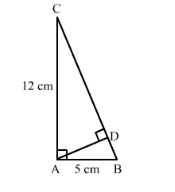In a $\triangle \mathrm{ABC}, \angle \mathrm{A}=90^{\circ}, \mathrm{AB}=5 \mathrm{~cm}$ and $\mathrm{AC}=12 \mathrm{~cm}$. If $\mathrm{AD} \perp \mathrm{BC}$, then $\mathrm{AD}=$
(a) 132cm
(b) 6013cm
(c) 1360cm
(d) 21513cm
Given: In $\triangle \mathrm{ABC} \angle \mathrm{A}=90^{\circ}, \mathrm{AD} \perp \mathrm{BC}, \mathrm{AC}=12 \mathrm{~cm}$, and $\mathrm{AB}=5 \mathrm{~cm}$.
To find: AD
We know that the ratio of areas of two similar triangles is equal to the ratio of squares of their corresponding sides.

In ∆ACB and ∆ADC,
∠C=∠C (Common)
∠A=∠ADC=90°
∴ ∆ACB ~∆ADC (AA Similarity)
$\frac{\mathrm{AD}}{\mathrm{AB}}=\frac{\mathrm{AC}}{\mathrm{BC}}$
$\mathrm{AD}=\frac{\mathrm{AB} \times \mathrm{AC}}{\mathrm{BC}}$
$\mathrm{AD}=\frac{12 \times 5}{13}$
$\mathrm{AD}=\frac{60}{13}$
We got the result as (b)
Click here to get exam-ready with eSaral
For making your preparation journey smoother of JEE, NEET and Class 8 to 10, grab our app now.
